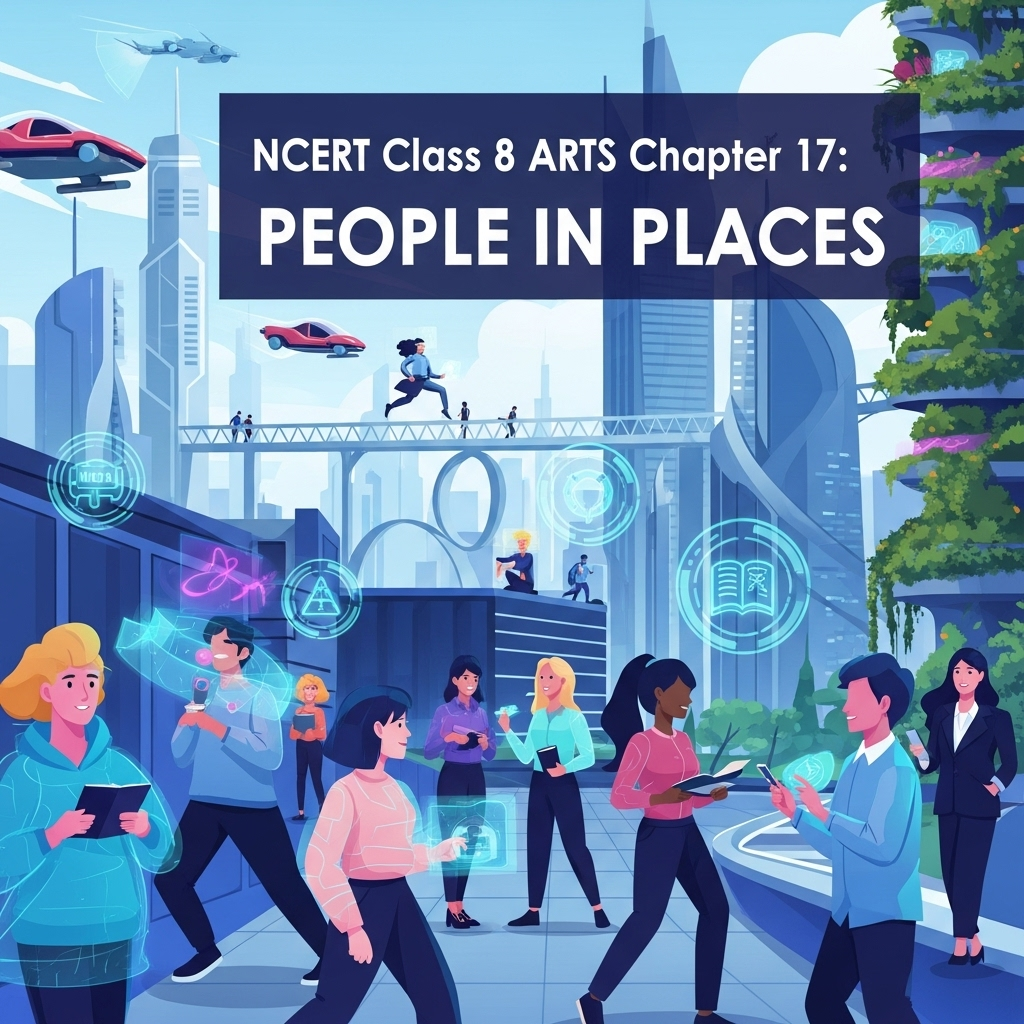Chapter Overview
3
Key Things for Perspective
1
Vanishing Point
100
Rupee Note Example
3
Eye Levels
What You'll Learn
Perspective Technique
Showing 3D space on 2D surface, creating illusion of distance/depth.
Horizon and Vanishing Point
Understanding eye level horizon, lines converging at vanishing point.
Visualizing Perspective
Eye as circle, center vanishing point, lines radiating.
Drawing in Perspective
Identify horizon, vanishing point, observe angles for realistic buildings.
Historical Context
Paintings/drawings transport to worlds; some 2D with lines/patterns/colors/textures, others 3D popping out; perspective creates 3D illusion on 2D.
Key Highlights
Parallel lines appear converge distance (roads/railways); horizon at eye level; vanishing point at eye level; draw perspective observing views; example Rani ki Vav on 100 rupee note.
Comprehensive Chapter Summary
1. Introduction to Perspective
Paintings/drawings power transport worlds; some 2D entice beauty lines/patterns/colors/textures; others 3D appear popping out surface; wondered how happens?
2. Definition and Creation
Perspective Technique
Showing three-dimensional space on two-dimensional surface; creates illusion distance/depth; closer bigger/more details, further smaller/less.
Observe Pictures
Lines either side road parallel but appear converge distance; same railway tracks.
Key Observations
Horizon line aligns eye level viewer; lines converge vanishing point also eye level.
3. Visualizing Perspective Lines
Eyeball Visualization
Eyeball as circle, center vanishing point; horizontal across center as horizon line; other lines radiating center different directions.
Above/Below Eye Level
Lines above/below eye level converge accordingly.
4. Drawing in Perspective
Important Things
1. Identifying horizon line eye level scene; 2. Visualising vanishing point; 3. Observing angle lines converge vanishing point.
5. Application
Perspective help observe/draw buildings/architectural monuments realistic way; example image printed 100 rupee note; lines upper/lower storeys stepwell appear converge vanishing point.
6. Rani ki Vav Stepwell
In Patan, Gujarat; example how perspective used.
Questions and Answers from Chapter
Short Questions
Q1. What is perspective?
Answer: Technique showing 3D space on 2D surface.
Q2. What creates illusion?
Answer: Distance and depth.
Q3. Closer things appear?
Answer: Bigger with more details.
Q4. Further things appear?
Answer: Smaller with less details.
Q5. What aligns with horizon?
Answer: Eye level of viewer.
Q6. Lines converge at?
Answer: Vanishing point.
Q7. Vanishing point at?
Answer: Eye level.
Q8. Visualize eyeball as?
Answer: Circle.
Q9. Center of eye?
Answer: Vanishing point.
Q10. Horizontal across center?
Answer: Horizon line.
Q11. Other lines do?
Answer: Radiating from center.
Q12. First important for draw?
Answer: Horizon line at eye level.
Q13. Second important?
Answer: Visualising vanishing point.
Q14. Third important?
Answer: Observing angle of lines.
Q15. Helps draw what?
Answer: Buildings and monuments realistically.
Medium Questions
Q1. Explain perspective creation.
Answer: Creates illusion distance/depth; closer bigger/more details, further smaller/less. (3 marks)
Q2. Describe road/railway observation.
Answer: Parallel lines appear converge distance; horizon aligns eye level. (3 marks)
Q3. What lines converge?
Answer: Converge at vanishing point also at eye level. (3 marks)
Q4. Visualize how lines appear?
Answer: Eyeball circle, center vanishing point, horizontal horizon, lines radiating. (3 marks)
Q5. To draw in perspective?
Answer: Identify horizon eye level, visualise vanishing point, observe angles converging. (3 marks)
Q6. Help observe/draw?
Answer: Buildings/architectural monuments realistic way. (3 marks)
Q7. Example on rupee note?
Answer: Lines upper/lower storeys stepwell converge vanishing point. (3 marks)
Q8. Rani ki Vav where?
Answer: In Patan, Gujarat. (3 marks)
Q9. Above eye level lines?
Answer: Appear sloping downward to vanishing point. (3 marks)
Q10. Below eye level lines?
Answer: Appear sloping upward to vanishing point. (3 marks)
Q11. At eye level lines?
Answer: Appear horizontal. (3 marks)
Q12. Vanishing point role?
Answer: Point where parallel lines converge in distance. (3 marks)
Q13. Horizon line role?
Answer: Aligns with eye level of viewer. (3 marks)
Q14. Practice by?
Answer: Keenly observing views in front. (3 marks)
Q15. Creates what?
Answer: Magic with practice. (3 marks)
Long Questions
Q1. Discuss power of paintings and drawings.
Answer: Transport to other worlds; some 2D entice beauty lines/patterns/colors/textures; others 3D appear popping out surface; wondered how happens.
Q2. Explain perspective technique.
Answer: Showing three-dimensional space on two-dimensional surface; creates illusion distance/depth; closer appear bigger/more details than further away.
Q3. Describe observations on pictures.
Answer: Lines either side road parallel appear converge distance; same railway tracks; horizon line aligns eye level viewer; lines converge vanishing point also eye level.
Q4. How visualize lines in perspective.
Answer: Eyeball circle center vanishing point; horizontal across center horizon line; imagine other lines radiating center different directions.
Q5. Discuss three important things to draw.
Answer: 1. Identifying horizon line eye level scene; 2. Visualising vanishing point; 3. Observing angle lines converge vanishing point.
Q6. Explain how perspective helps.
Answer: Help observe/draw buildings/architectural monuments way looks realistic; take example image printed 100 rupee note.
Q7. Describe rupee note example.
Answer: Lines upper/lower storeys stepwell appear converge vanishing point; Rani ki Vav Stepwell Patan, Gujarat.
Q8. How lines appear above eye level.
Answer: Appear sloping downward toward vanishing point.
Q9. How lines below eye level.
Answer: Appear sloping upward toward vanishing point.
Q10. Lines at eye level.
Answer: Appear horizontal.
Q11. Vanishing point in visualization.
Answer: Center eye in circle visualization.
Q12. Horizon line in visualization.
Answer: Horizontal line across center eye.
Q13. Radiating lines.
Answer: Other lines radiating from center different directions.
Q14. Create magic how?
Answer: With practice keenly observing views front you.
Q15. Perspective creates illusion.
Answer: Creates illusion distance/depth on flat surface.




